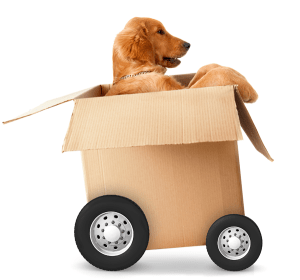Moving is an all-encompassing event. Depending on how far you’re going, it can also be incredibly traumatic for adults and children in the family. Then there’s the stress of living in a house turned upside down with packing, making all of the logistical arrangements, and so on. But, don’t forget that moving can be stressful for pets too and they often get forgotten in the shuffle.
Your pets don’t understand moving. The stress levels can be even higher for rescued pets, who may associate the packing and moving with prior abandonment. There are a handful of things you can do to make moving with pets as peaceful and low-stress as possible for everyone involved.

6 Tips for Stress-free Moving With Pets
- Make a vet appointment. If your pet requires medication, routine shots, etc., make an appointment with your vet and get up to date so you have everything you need as you settle into your new place. Ask your vet if she has any recommendations for veterinarians in your new location. Also, get copies of your pet’s records so you can give them to your new veterinarian.
- Update your pet’s tags and microchip. Most people wait until after they are in their new home to update their pet’s tags and microchip. This isn’t a good idea. Pets often bolt when they are scared or agitated. If they bolt from your new home before they have their new tags and updated microchip, it will be harder for people to find and locate you.
- Keep your pets away from the action. We always recommend that our clients enlist the help of family members, friends, or professional sitters to help take care of their pets and their children during the moving process. It’s one less thing for parents to worry about and it keeps little people and creatures from getting underfoot as heavy objects and boxes are moved into and out of the moving truck. If this isn’t possible, try to clean out one room in the house ahead of time and let your pets stay in there with food, water, beds and a few favorite objects. If your pets are highly-sensitive, you may want to use a crate to make them feel more safe.
- Talk to airlines one month in advance. If your pet will be flying to your new destination for a long distance move, talk to the airlines a month or two ahead of time so you are 100% clear on their rules and regulations as well as any fees, shots, or records you will need to provide on travel day.
- Prepare your new home for your pets. Once you arrive to your new home, walk your dog through the house so he can get familiar with the new smells. Find a quiet space, such as a bathroom, large walk-in closet, or small room and keep the pets contained with their food, water, beds, etc. as you unload the truck. If you have the time and energy, take your dog(s) on a walk around the neighborhood so they can get a feel for their new environment with you. If your move was relatively local, leave your contact information for the people moving into your old home so you can be contacted if your pets return back there.
- Find a good vet. If your current vet doesn’t have personal recommendations, use neighbor referrals and online review sites to select a few vet offices. Then make appointments to meet them and choose the one that seems best suited for your family.
Looking for ways to make your upcoming move as smooth as possible? Contact Jay’s Small Moves.
